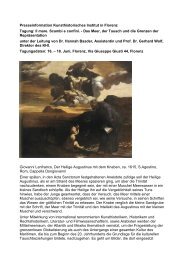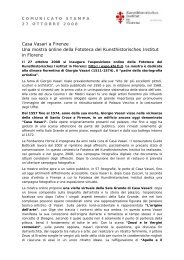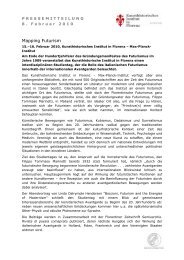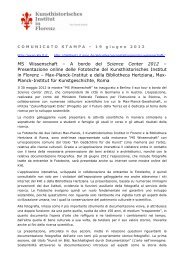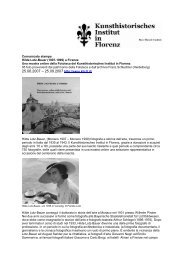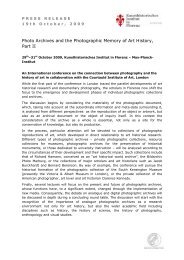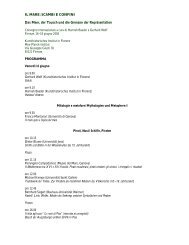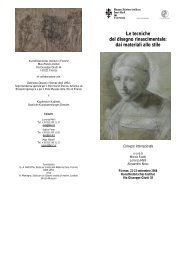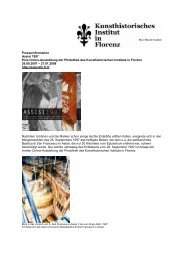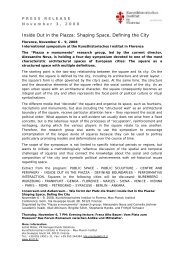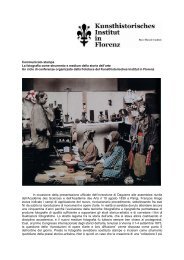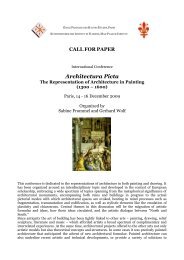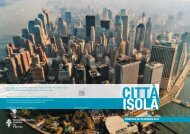juli 2012 - Kunsthistorisches Institut in Florenz
juli 2012 - Kunsthistorisches Institut in Florenz
juli 2012 - Kunsthistorisches Institut in Florenz
You also want an ePaper? Increase the reach of your titles
YUMPU automatically turns print PDFs into web optimized ePapers that Google loves.
38 | WISSENSCHAFTLICHE VERANSTALTUNGEN<br />
STUDIENKURSE | SUMMER SCHOOLS<br />
18.–26.09.2009<br />
Concept and Organization<br />
Hannah Baader<br />
Av<strong>in</strong>oam Shalem<br />
Gerhard Wolf<br />
Experts<br />
Charles Burnett<br />
(Warburg <strong>Institut</strong>e, London)<br />
Roberto Corneo<br />
(Università di Cagliari)<br />
Pisa and the Mediterranean<br />
Summer School<br />
Dur<strong>in</strong>g the Middle Ages, Pisa was one of the most important port cities of the Mediterranean, <strong>in</strong> permanent<br />
competition with Genoa and Venice. In fact, Pisan politics m<strong>in</strong>gled religious, economic and military <strong>in</strong>terests.<br />
The Maritime Republic had <strong>in</strong>vaded Muslim Palermo <strong>in</strong> 1063, Mahdyia <strong>in</strong> 1087 as well as Jerusalem <strong>in</strong> the<br />
first crusade, had expelled the Muslims from the Balearic Islands (1113–115), captured Sard<strong>in</strong>ia, but at<br />
almost the same time was also stipulat<strong>in</strong>g treatises, e.g. with the ruler of Tunis <strong>in</strong> 1157, and was apparently<br />
us<strong>in</strong>g the crusade to establish trad<strong>in</strong>g posts <strong>in</strong> the coastal cities of Syria, Lebanon and Palest<strong>in</strong>e. It <strong>in</strong>stalled<br />
larger or smaller colonies <strong>in</strong> Antioch, Acre, Jaffa, Tripoli, Tyre, Joppa, Latakia, Jerusalem, Caesarea, Cairo,<br />
Alexandria and last but not least <strong>in</strong> Constant<strong>in</strong>ople.<br />
An <strong>in</strong>scription on the cathedral façade declares that the build<strong>in</strong>g was made possible by the riches that the<br />
Pisans had looted dur<strong>in</strong>g the course of the <strong>in</strong>vasion of Palermo. Another <strong>in</strong>scription confirms that this sanctuary,<br />
be<strong>in</strong>g white like snow, is without a prototype. Stress<strong>in</strong>g its pure whiteness, the <strong>in</strong>scription evokes a<br />
concept of renewal, typical of the second half of the 11 th century. In the follow<strong>in</strong>g two centuries this concept<br />
stimulated not only the construction of the cathedral, but the whole ensemble of the famous Piazza dei<br />
Miracoli, made of light marble from the nearby Apuan Alps and designed on an extreme monumental scale.<br />
Situated at the North Western corner of the old town and enclosed on two of sides by the city wall, the Piazza<br />
dei Miracoli is one of the most extravagant sacred topographies <strong>in</strong> the Christian culture of the Middle Ages,<br />
beg<strong>in</strong>n<strong>in</strong>g with the cathedral, followed by the baptistery (1152), the bell tower (1173) and f<strong>in</strong>ally concluded<br />
by the Campo Santo (begun <strong>in</strong> 1278, f<strong>in</strong>ished after 1350).<br />
Architectural and decorative forms as well as constructive aspects of the ensemble not only relate to<br />
Byzantium, Catalonia and Southern France, but also to the Muslim world of the Eastern Mediterranean,<br />
North Africa and Al Andaluz, <strong>in</strong>clud<strong>in</strong>g the Great Mosque <strong>in</strong> Cordoba. Pisan art can thus be studied <strong>in</strong> its<br />
particular ability to amalgamate different formal elements <strong>in</strong> an astonish<strong>in</strong>gly unique and unified structure.<br />
The <strong>in</strong>novative artistic and <strong>in</strong>tellectual climate <strong>in</strong> Pisa <strong>in</strong>cludes new forms of technological and scientific<br />
knowledge. The most famous case is that of the mathematician Leonardo Fibonacci who wrote the groundbreak<strong>in</strong>g<br />
treatise De Libro Abaci (1227) referr<strong>in</strong>g to Indian and Arabian arithmetics which, accord<strong>in</strong>g to his<br />
<strong>in</strong>troduction, he learned <strong>in</strong> an abbacus school <strong>in</strong> his early youth <strong>in</strong> Bejaia <strong>in</strong> Algeria, where his Father served<br />
as a notary of the Pisan republic.<br />
The summer school <strong>in</strong> Pisa <strong>in</strong>vestigates how one of the lead<strong>in</strong>g Mediterranean port cities of the Middles Ages<br />
responded to its heterogeneous cultural experiences <strong>in</strong>tellectually and artistically. The sem<strong>in</strong>ar discusses<br />
the architecture of the Piazza dei Miracoli, the sculpture of the Pisani, the frescoes of the Campo Santo and<br />
other monuments of the city. It also <strong>in</strong>cludes an excursion to Sard<strong>in</strong>ia to visit major medieval monuments<br />
of the island which was temporarily under Pisan dom<strong>in</strong>ion. F<strong>in</strong>ally, as counter-evidence, the situation from<br />
1063 to ca. 1320/1350 is compared with the later development after the Florent<strong>in</strong>e capture of Pisa <strong>in</strong> 1406.<br />
In the wake of the modern concepts of territoriality, the Medici archdukes tried to separate religious and commercial<br />
<strong>in</strong>terests with<strong>in</strong> their state more clearly: turn<strong>in</strong>g Pisa <strong>in</strong>to the realm of the military religious Order<br />
of Santo Stefano and at the same time found<strong>in</strong>g a liberal commercial harbour <strong>in</strong> Livorno. While expressly<br />
accept<strong>in</strong>g the diffusion of holy books of all religions <strong>in</strong> Livorno, the Medici, with Pietro Tacca’s monument<br />
for Fernd<strong>in</strong>ando I, concurrently made use of new ways of claim<strong>in</strong>g cultural supremacy <strong>in</strong> the public space.<br />
09.–17.05.2010<br />
Concept and Organization<br />
Hannah Baader<br />
Av<strong>in</strong>oam Shalem<br />
Gerhard Wolf<br />
Sponsored by<br />
The Getty Foundation<br />
Guest scholar<br />
Jonathan Bloom<br />
(Boston College of Art<br />
and Sciences)<br />
Experts<br />
Taher Ghalia<br />
(Musée National du Bardo)<br />
Lotfi Abd Eljaoued<br />
(Musée des Arts Islamiques,<br />
Kairouan- Raqqada)<br />
Interactions <strong>in</strong> the Mediterranean Bas<strong>in</strong>: The Case of Late Classical, Aghlabid and Fatimid Tunisia (Tunis/<br />
Mahdiyya/Qayrawan)<br />
Summer School<br />
The art of Ifriqiya is one of the most fasc<strong>in</strong>at<strong>in</strong>g areas of medieval Islam. It presents visually the process by<br />
which Roman, Late Antique, and Byzant<strong>in</strong>e cultures were <strong>in</strong>tegrated to create a new aesthetic language for<br />
a region under a muslim rulership and demonstrates <strong>in</strong>novative methods of shap<strong>in</strong>g holy spaces <strong>in</strong> early<br />
medieval Islam, be it Sunni (Qayrawan) or Shiite-Fatimid (Mahdiyya). The city of Qayrawan, with its mosques,<br />
is one of the most holy places <strong>in</strong> Islam after Mecca, Med<strong>in</strong>a, and Jerusalem, and Mahdiyya is the first official<br />
city build by the Fatimid dynasty. By shift<strong>in</strong>g the direction of the scholarly gaze to this specific space which<br />
is located <strong>in</strong> the heart of the Mediterranean bas<strong>in</strong>, the Summer School <strong>in</strong> Tunisia considers the art, architecture<br />
and urbanism of Ifriqiya and its relationships to neighbor<strong>in</strong>g cultures <strong>in</strong> a different and broader light.<br />
The proximity between Africa and Europe <strong>in</strong> this particular geographical space; the active medieval naval<br />
trade routes l<strong>in</strong>k<strong>in</strong>g Ifriqiya to South Italy, Sicily, Al-Andalus and to the eastern ports of the Mediterranean<br />
Sea; the land routes of the sub-Saharan trade that cross this region; the constant l<strong>in</strong>ks with other Muslim<br />
centers like Abassid Misr (Egypt), Baghdad, Samarra, Mecca and Med<strong>in</strong>a; and the <strong>in</strong>teractions, <strong>in</strong> peaceful<br />
or violent times, <strong>in</strong>volv<strong>in</strong>g the movements of people, ideas and artifacts, made it a symbiotic region of land<br />
and water with cities which became for a certa<strong>in</strong> period centers of the medieval world. Study<strong>in</strong>g the art<br />
and architecture of Ifriqiya through a magnify<strong>in</strong>g glass, from this particular perspective and with<strong>in</strong> Ifriqiya’s<br />
»global« Mediterranean context contributes to the understand<strong>in</strong>g of the emergence of a new multi-facetted,<br />
aesthetic and visual language <strong>in</strong> the medieval Mediterranean sphere.<br />
A specific emphasis is given to <strong>in</strong>novative military architecture (ribat and Qal’a) and the <strong>in</strong>teraction of its<br />
aesthetic language with palatial and religious architecture. Moreover, the colonial historiographies of Tunisia<br />
and the construction of Tunisia’s visual-cultural narrative is considered critically, especially through study of<br />
the history of museums and the display of archaeological objects.<br />
The Summer school is part of the research program »Art, Space and Mobility <strong>in</strong> the Early History of Globalization.<br />
The Mediterranean, Central Asia and the Indian Subcont<strong>in</strong>ent 400–1650«.



